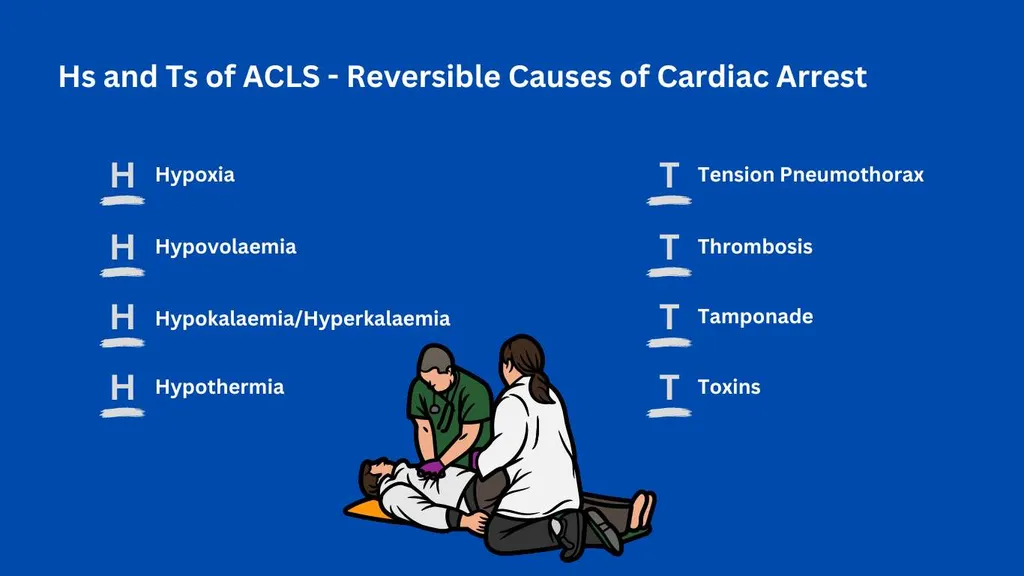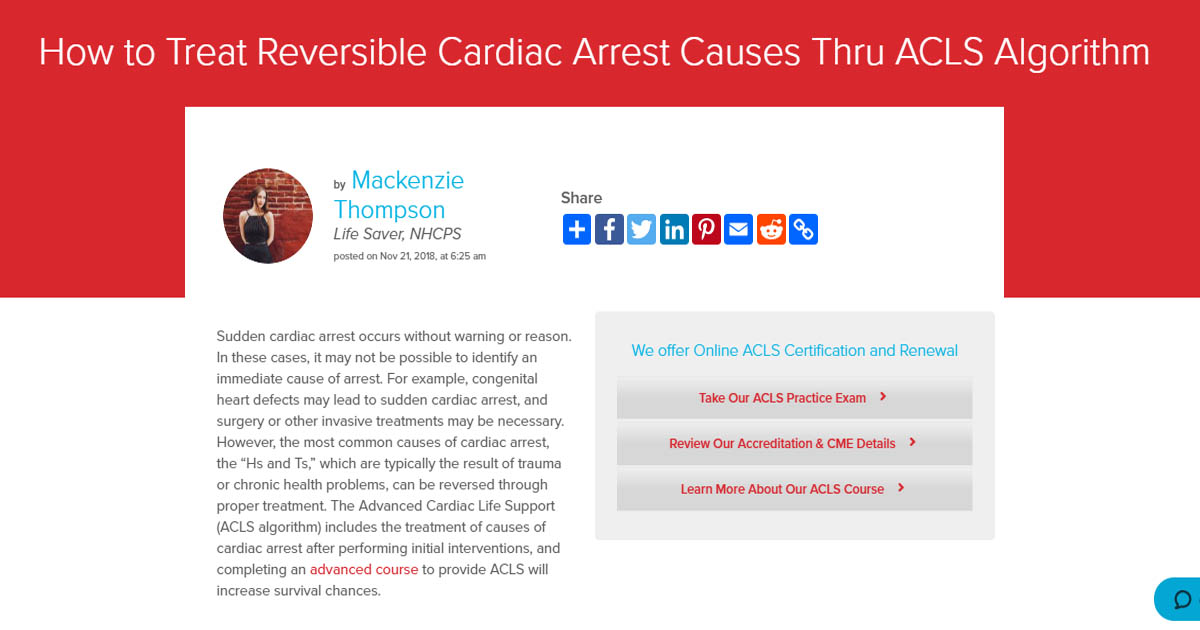Reversible Causes Of Cardiac Arrest Acls - Hypovolemia is the decrease in the volume of blood in your body,. Pulseless electrical activity (pea), asystole, ventricular fibrillation (vfib or vf), and ventricular tachycardia (vtach or vt) may have. Trauma can be a cause of pulseless arrest, and a proper evaluation of the patient’s physical condition and history should reveal any. In total there are twelve reversible conditions that make up the h’s & t’s: During any cardiac arrest, part of the resuscitation effort must focus on identifying and treating potentially reversible causes — the conditions.
Hypovolemia is the decrease in the volume of blood in your body,. Trauma can be a cause of pulseless arrest, and a proper evaluation of the patient’s physical condition and history should reveal any. Pulseless electrical activity (pea), asystole, ventricular fibrillation (vfib or vf), and ventricular tachycardia (vtach or vt) may have. In total there are twelve reversible conditions that make up the h’s & t’s: During any cardiac arrest, part of the resuscitation effort must focus on identifying and treating potentially reversible causes — the conditions.
During any cardiac arrest, part of the resuscitation effort must focus on identifying and treating potentially reversible causes — the conditions. Hypovolemia is the decrease in the volume of blood in your body,. In total there are twelve reversible conditions that make up the h’s & t’s: Trauma can be a cause of pulseless arrest, and a proper evaluation of the patient’s physical condition and history should reveal any. Pulseless electrical activity (pea), asystole, ventricular fibrillation (vfib or vf), and ventricular tachycardia (vtach or vt) may have.
Beyond ACLS POCUS in Cardiac Arrest REBEL EM Emergency Medicine Blog
During any cardiac arrest, part of the resuscitation effort must focus on identifying and treating potentially reversible causes — the conditions. Hypovolemia is the decrease in the volume of blood in your body,. Pulseless electrical activity (pea), asystole, ventricular fibrillation (vfib or vf), and ventricular tachycardia (vtach or vt) may have. Trauma can be a cause of pulseless arrest, and.
Reversible Causes of Cardiac Arrest Beyond the H's and T's
In total there are twelve reversible conditions that make up the h’s & t’s: Hypovolemia is the decrease in the volume of blood in your body,. During any cardiac arrest, part of the resuscitation effort must focus on identifying and treating potentially reversible causes — the conditions. Trauma can be a cause of pulseless arrest, and a proper evaluation of.
Dr Joshua Walinjom on Twitter "Reversible causes of cardiac arrest"
Hypovolemia is the decrease in the volume of blood in your body,. During any cardiac arrest, part of the resuscitation effort must focus on identifying and treating potentially reversible causes — the conditions. In total there are twelve reversible conditions that make up the h’s & t’s: Pulseless electrical activity (pea), asystole, ventricular fibrillation (vfib or vf), and ventricular tachycardia.
ACLS Guidelines 2015 Update Adult Cardiac Arrest
Hypovolemia is the decrease in the volume of blood in your body,. During any cardiac arrest, part of the resuscitation effort must focus on identifying and treating potentially reversible causes — the conditions. Trauma can be a cause of pulseless arrest, and a proper evaluation of the patient’s physical condition and history should reveal any. In total there are twelve.
Cardiac Arrest
In total there are twelve reversible conditions that make up the h’s & t’s: Hypovolemia is the decrease in the volume of blood in your body,. Trauma can be a cause of pulseless arrest, and a proper evaluation of the patient’s physical condition and history should reveal any. Pulseless electrical activity (pea), asystole, ventricular fibrillation (vfib or vf), and ventricular.
Reversible Causes of Cardiac Arrest The Four Hs and Four Ts
Trauma can be a cause of pulseless arrest, and a proper evaluation of the patient’s physical condition and history should reveal any. In total there are twelve reversible conditions that make up the h’s & t’s: Pulseless electrical activity (pea), asystole, ventricular fibrillation (vfib or vf), and ventricular tachycardia (vtach or vt) may have. During any cardiac arrest, part of.
Hs and Ts 8 Reversible Causes of Cardiac Arrest Heart Start CPR
During any cardiac arrest, part of the resuscitation effort must focus on identifying and treating potentially reversible causes — the conditions. Hypovolemia is the decrease in the volume of blood in your body,. In total there are twelve reversible conditions that make up the h’s & t’s: Trauma can be a cause of pulseless arrest, and a proper evaluation of.
How to Treat Reversible Cardiac Arrest Causes Thru ACLS Algorithm
During any cardiac arrest, part of the resuscitation effort must focus on identifying and treating potentially reversible causes — the conditions. Hypovolemia is the decrease in the volume of blood in your body,. Trauma can be a cause of pulseless arrest, and a proper evaluation of the patient’s physical condition and history should reveal any. Pulseless electrical activity (pea), asystole,.
ACLSCardiacArrestAlgorithm ECCpodcast
Pulseless electrical activity (pea), asystole, ventricular fibrillation (vfib or vf), and ventricular tachycardia (vtach or vt) may have. During any cardiac arrest, part of the resuscitation effort must focus on identifying and treating potentially reversible causes — the conditions. In total there are twelve reversible conditions that make up the h’s & t’s: Hypovolemia is the decrease in the volume.
Hs and Ts 8 Reversible Causes of Cardiac Arrest Heart Start CPR
Trauma can be a cause of pulseless arrest, and a proper evaluation of the patient’s physical condition and history should reveal any. During any cardiac arrest, part of the resuscitation effort must focus on identifying and treating potentially reversible causes — the conditions. Hypovolemia is the decrease in the volume of blood in your body,. Pulseless electrical activity (pea), asystole,.
Hypovolemia Is The Decrease In The Volume Of Blood In Your Body,.
In total there are twelve reversible conditions that make up the h’s & t’s: Pulseless electrical activity (pea), asystole, ventricular fibrillation (vfib or vf), and ventricular tachycardia (vtach or vt) may have. Trauma can be a cause of pulseless arrest, and a proper evaluation of the patient’s physical condition and history should reveal any. During any cardiac arrest, part of the resuscitation effort must focus on identifying and treating potentially reversible causes — the conditions.









